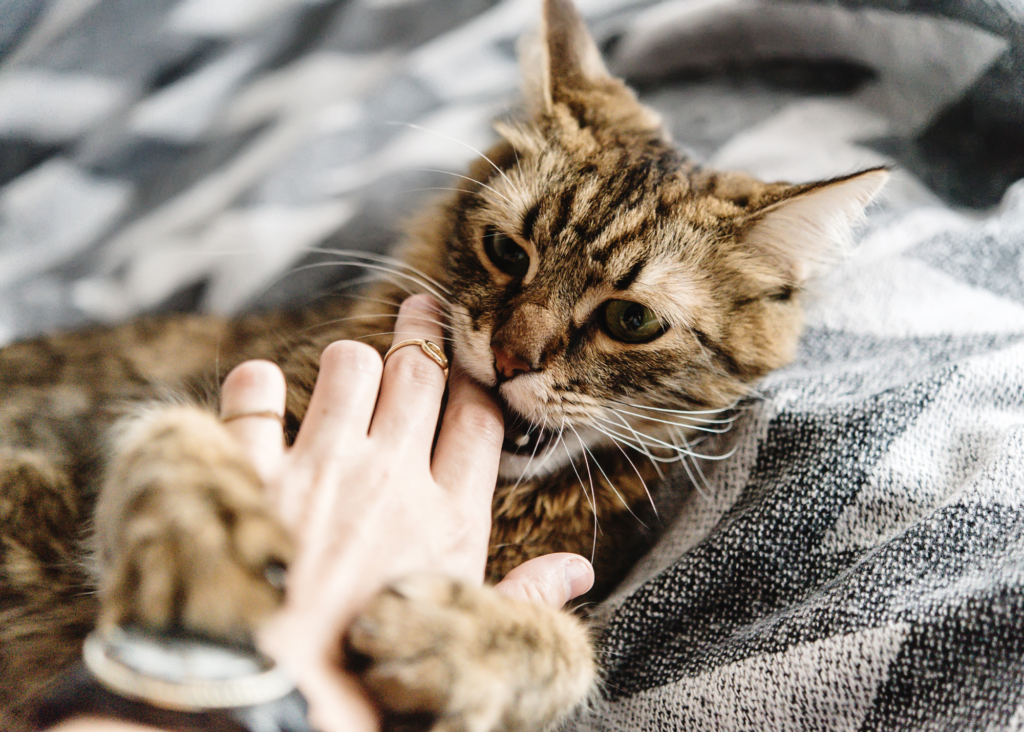How to Stop a Cat Biting and Scratching Your Hand for Treats
Do you have a problem with your cat biting and scratching your hand when you are training? A persistent cat’s sharp claws and teeth can quickly ruin the fun in a training session.
However, if you have a grabby cat, that means they are highly motivated to work, which is a good thing! You just have to work on getting them to control themselves.
The training agreement you create with your cat goes like this: “Do behavior X, and THEN you get your treat.”
A cat that’s less food-motivated might walk away. “Sorry, the terms of this agreement are not up to my standards.” Ask someone to do a job when they think they deserve more money, and chances are they will quit. (If this is your cat, read this article about how to increase your cat’s food motivation.)
On the flip-side, a food-motivated cat will quickly do what you’ve asked. “Fine, I did that, now GIMME my treat!” They are highly satisfied with their paycheck and eager to show up for work.
So how does a new cat trainer keep their fingers free from scratches and bites?

5 Tips for Working with a Grabby Cat
1. Experiment with lower valued food.
Have you ever had trouble concentrating when your favorite food is on the table? Sometimes good food can be very distracting. When people first start training, they may think they need to use the best treats. Ideally, we want to use the lowest valued foods to teach the basics, and reserve the best treats for the challenging training tasks, like nail trims. Experiment with different foods for different jobs, and find something that brings out your cat’s best behavior.
2. Use props.
Using props is an excellent strategy to take the focus away from your hands. Working with a target stick can help teach your cat how clicker training works while preserving your fingers. Click for touching the target stick and place the treat on the floor or toss it away from you. My fist bump tutorial is an excellent beginner exercise because your cat learns to target a container and not your hand.
3. Teach that treats don’t come from the hand that cues them.
Teach the cat that the treat doesn’t come from the hand that presents the cues. Let’s consider what happens when you teach your cat to target your finger. Initially, you may have a treat in your hand to lure (guide) them. Click, before the cat makes contact with your finger and surprise them with a treat that comes from your OTHER hand. “What – there are treats in both hands now?!”
This exercise will teach your cat that treats come from where they least expect it and encourages them to work even when they don’t see a treat.
4. Do distance work.
The Go To A Bed or Mat tutorial turns the focus away from your fingers to an object. The Teach Your Cat to Perch tutorial uses the same principle. The cat learns that contact with the object (not you) is what will earn them a reward.
5. Click for the absence of grabbing.
A clicker is a precise tool that allows you to reinforce your cat for the absence of bad behavior. In this video, I am doing a simple impulse control exercise. I place a treat on my hand and present my hand up high out of Jones’ reach. As I lower my hand, I click Jones for stillness.
Using the clicker, I communicate to Jones that even when there is a treat on my hand, the Sit behavior is what will earn him the reward. I hope you can see what a powerful device the clicker is in helping your cat learn that patience not pushiness is how they win treats.
As you work through these exercises, avoid getting frustrated with your cat. Remember it’s your job to teach them the rules of this clicker training game. Every cat can learn to be a polite and gentle training partner.

